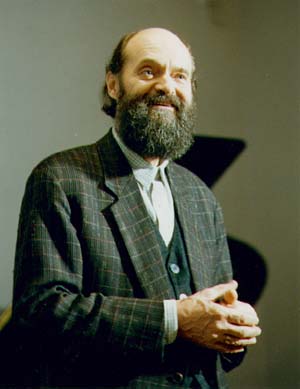In Celebration of the Human Voice - The Essential Musical Instrument
Home | Doo Wop | Barbershop | World | Contemporary | Christian | Vocal Jazz | Choral | Christmas | Instructional | Arrangements
Classical | Opera | Musicals | Personality | Young Singers | Disney | Videos | Songs | The Artists

Arvo Part Biography

Click Here for Sheet Music and Songbook Vocal Arrangements
The composer Arvo Part (pronounced "pairt") was born in Estonia in 1935. Although at that time Estonia was a nascent independent republic, the Soviet Union took control of it in 1940, and stayed except for a brief period under the Nazis, for the next 54 years. Arvo PartPart's musical education began at age 7, and by 14 or 15 he was writing his own compositions. While studying composition at the Tallinn Conservatory it was said of him that: "he just seemed to shake his sleeves and notes would fall out". There were very few influences from outside the Soviet Union at this time, just a few illegal tapes and scores. Part's oeuvre is generally divided into two periods, and he is best known for his more recent works. The early works range from rather severe neo-classical styles influences by Shostakovich, Prokofiev and Bartok. He then began to compose using Schoenberg's twelve-tone technique and serialism, but this not only earned the ire of the Soviet establishment, but also proved to be a creative dead end. Part's biographer, Paul Hillier, says: "... he had reached a position of complete despair in which the composition of music appeared to be the most futile of gestures, and he lacked the musical faith and will-power to write even a single note" This may be an overstatement since the transitional third symphony was composed during this time. However, it is clear that Part experienced a deep crisis. His response to this impasse was to immerse himself in early music, to go in effect back to the very roots of western music. He studied plainsong, Gregorian chant, and the emergence of polyphony in the Renaissance. At the same time he began to explore religion and joined the Russian Orthodox Church, perhaps indicating that the crisis was spiritual in nature, rather than simply musical. The music that began to emerge after this period was radically different. Part describes it as tintinnabular : as like the ringing of bells. The music is characterised by simple harmonies, often single unadorned notes, or triad chords which form the basis of western harmony. These sound like ringing bells, hence the name. The Tintinnabuli are rhythmically simple, and do not change tempo. The influence of early music is clear. Another characteristic of Part's later works is that they are frequently settings for sacred texts, although he mostly chooses Latin texts rather than Estonia, or the Slavonic used in Orthodox liturgy. Part is unusual for a modern composer in that he is very popular in his own lifetime. Part has said that his music is similar to light going through a prism: the music may have a slightly different meaning for each listener, thus creating a spectrum of musical experience, similar to the rainbow of light. |
Select a Category |
Want to Sing? - Find a Chorus Near You
List of Choruses by State | List of Choruses by City
